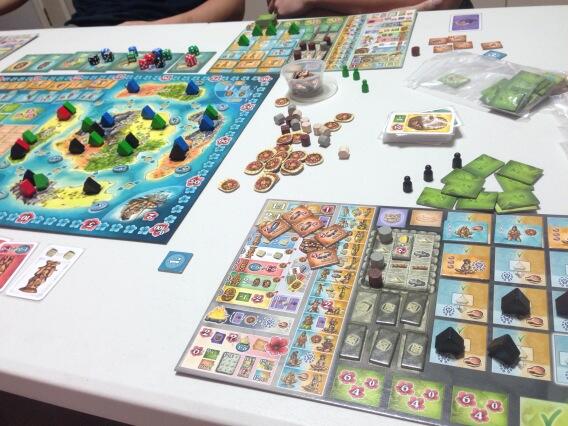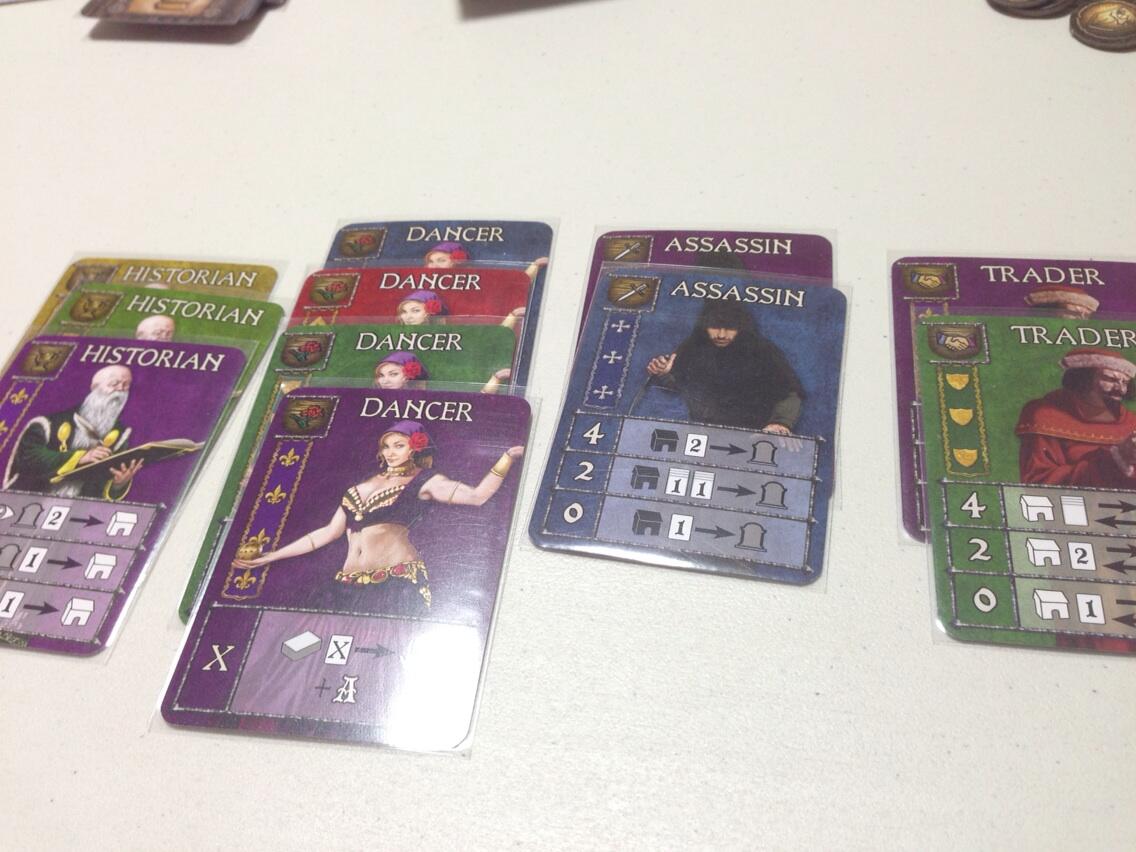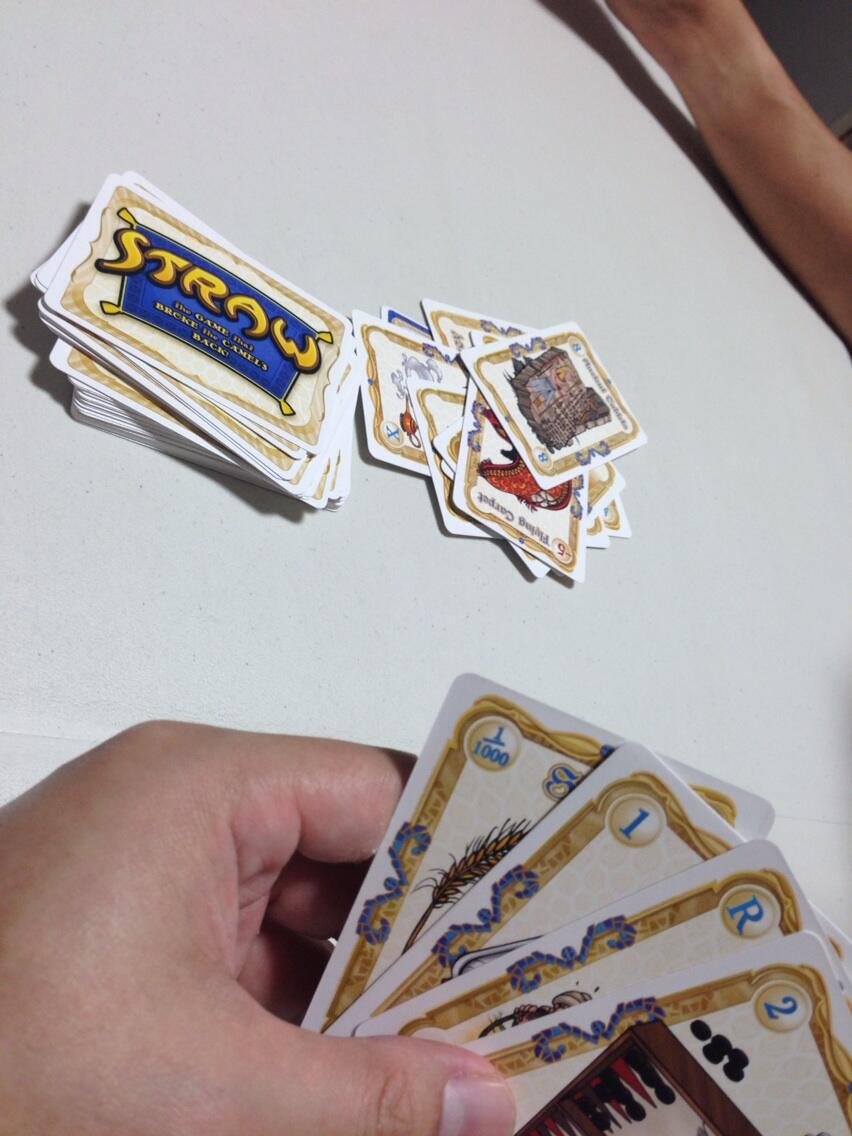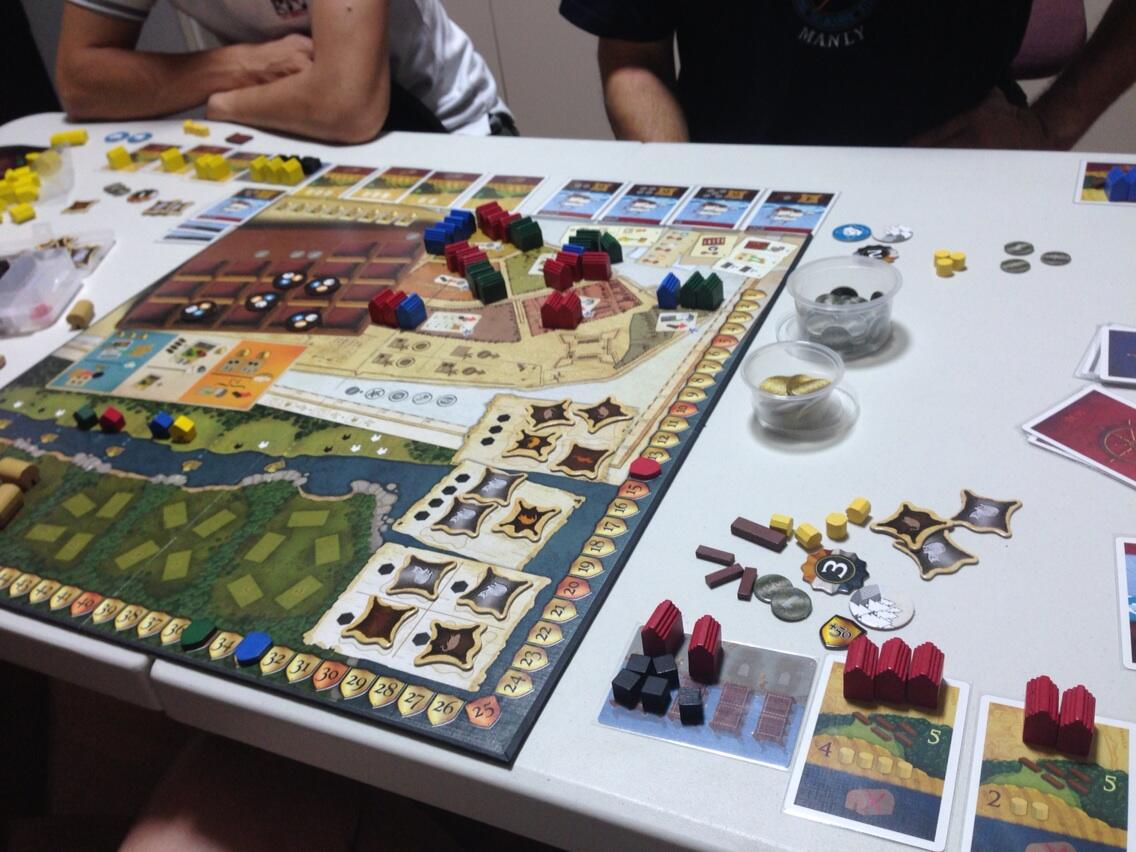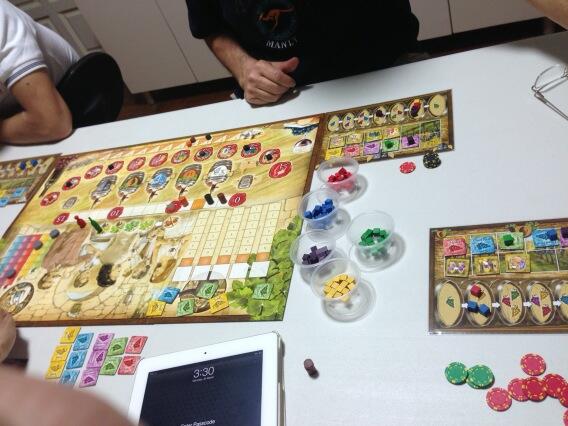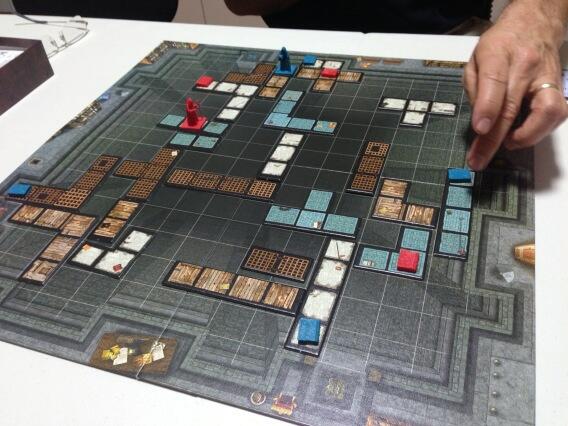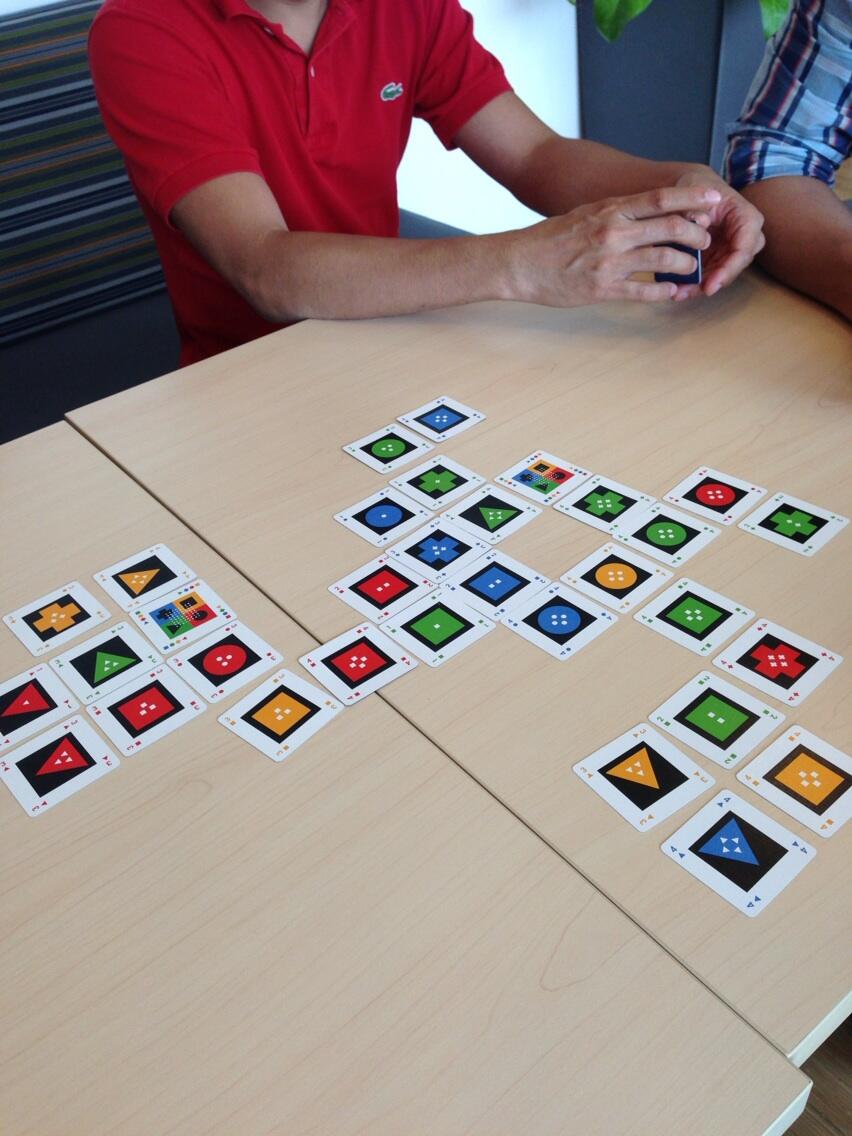NIEUW AMSTERDAM
 |
| You CAN score in both Land and Shipping! Interesting... |
Game Session and Thoughts:
This time I started off with the Fur route but seeing how no one was going for the businesses, I switched plans halfway. Its interesting playing with an opponent that calculates a lot and makes it a point to force you to make the hard decisions during auctions. The winner started off with land to get the necessary engine running while storing up on fur and near the midpoint of the game switched to fulfilling the ships, thus scoring a butt load of points from the ships and the end game scoring. My businesses strategy did not put a big dent and he won with about 100+ points. First time I have seen someone scoring past 100. Very good game still and I am loving how the theme somewhat clicks together now for me. Still highly recommended by me and do give it a go if you have a chance!
BATMAN GOTHAM CITY
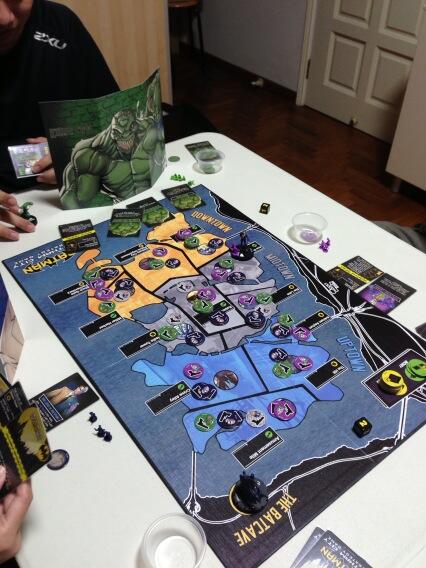 |
| Nanananananananana BATMAN! |
Game Session and Thoughts:
I am a fan of comics and Batman has always been quite a good read for me especially if it has cross overs with Judge Dread :P I have also played the video games so I was pretty interested to get this game and give it a go. Now the reviews have been pretty mixed and certainly it is a more ameritrash type of game and may not appeal to my now euro-gaming senses but well, its BATMAN! How bad can it be? At the very least I will get to go "NahnahnahnahNahnahnahnah BATMAN"
Each player will have 5 cards in their hand and during their turn, they will first check if they have levelled up based on the requirements for that level. Then they will play 1 card. The top part of the card usually provides income for the owner of that location (friendly ties). Unless its a Batman card which then triggers a drawing of a batman card and resolving that card. Next, the player decides if he/she wants to play the 2nd part of the card he/she played OR discard it to draw 2 resources. If there is any combat (triggered when the player's Villan appears in the same location as another Villan OR Batman, resolve that combat (villans and batman don't really die in this game). Draw a card and your turn is done. Play goes to the next player and this continues until 1 player has reached Level 10 with his villan and wins the game.
NAhnahanahanahanahan BATMAN..... We keep uttering that everytime its our turn lol. That does help to make the game more fun for us. Initially we were really into the game, playing our moves, roleplaying a little, singing that silly tune but then the flaws started appearing for us. Soon it got a bit too draggy and we decided to stop for dinner. Killer Croc was quite powerful, causing most of us to hide our Villans in their lairs until we grew powerful enough to come out and face him. Batman wasn't really a hindrance to us and we mostly swatted him away. I got ganged up upon because my first move was to disturb others so most of the time i was a docile Penguin. Components are quite good though the threat tokens are cardboard discs which for me, somehow feels a bit cheap. Dice are really nice as they have the batman logo engraved on it. They could have provided something better to represent like wooden discs or something but that could make the prices go up. Art is very cartoony and I like. There are HUGE player shields to hide your items behind and it has all the rules printed on them as well for players to reference.
Pet Peeves:
Boy, where do I begin?
Card draw luck is quite a big factor in the game. If you draw very sucky cards and you are not there at the location to benefit from it, you can end up providing a lot of income to the other player(s). At the same time, dice rolling luck is a slightly smaller factor in the game because while it determines outcomes of your battles, you can negate it with enough henchmen in that area. The spaces can be quite small and the areas could be quickly filled up with chits and villans but this is a smaller pet peeve. Player shields are REALLY BIG such that very often as we move our pieces or reach over the board, we will knock them over and expose our hidden pieces. I think the reason for such big shields is to include the rules but it could have been smaller or sturdier. Killer Croc might be overpowered because his power cards really do encourage him to seek the other Villans out to kick their asses.
But the BIGGEST pet peeve I have with the game is that it is very hard to win and it will take quite a long time to reach there. This is similar to how I feel for Spartacus and its like a Munchkin problem. Players will be able to tell who is in the lead and may work together to stop that leader. In that way, the game could drag on for very long as the game ends only when a player reaches level 10. Moreover, it is really hard to level up once past Level 6 as the conditions are quite difficult. We played for almost 2+ hours and I was only at level 3 and Killer Croc was at 7. This also kinda shows that if you are way way behind it is very difficult for you to catch up.
Conclusion:
Well, the game requires some tweaking and house ruling in order to make it playable. As it is right now, it CAN be fun but it requires the right group to play it to be fun. Otherwise, it is draggy and not much variety. Batman seems a bit impotent right now as he is easily beaten back to the batcave. He doesn't really make a big dent in our plans because his threat clearing numbers are pretty low. You really need to spread your threat around so that you can at least benefit whenever other players are playing cards. That is very important so that you are at least on par with the rest and won't lose out in terms of getting resources. I will want to play it again with my regular Friday group and see if we can get more fun out of it. As of now, its a Try before you Buy!
Nahnanananananana BATMAN!
FIRST TRAIN TO NUREMBERG
 |
| Choo choo! Come on get on the train people! |
Game Session and Thoughts:
So I have had a few train games in my collection last time but nothing like 18xx that sort. When I read about this and seeing the good reviews its been getting, I decided to give it a go. Players are trying to score as many points as they can, shipping goods and passengers all over the map and scoring points. All the while trying to keep a positive income flow so that they can also score more points at the end of the game. As an extra bonus, if you connect Nuremberg to the red stations, you will score a point for every link that are used for connecting. The game lasts 5 rounds and whowever has the most points at the end of the game will win it.
Each round is played over several phases. In the very first phase, players will be using investment cubes (every round you will get at least 12 + those that remained in previous terms) to bid onto a few auction spaces. These auction spaces will grant the winner of the bid influence points in the various categories which will determine what you can do in the next few phases. Bidding is such that each player can only win a maximum of 2 spaces and you can only shift your investment cubes to another spot if you are outbid on your current bids. once the auction is resolved, each player's disc on the various areas will increase based on the influences they have gained. There are a few tracks on the board and, briefly, they are: Train/Engine which will determine how much money you may spend to use trains for delivery; White colored influence which determine player order in terms of laying tracks and also used to pay off white meeples on the board when your tracks meet them; Green colored influence which are required when you start your track from a green station and also to sell tracks to the Green company at a later phase in the round; Red colored influence which are similar to Green colored influence;
The next phase after the auction is laying of tracks and each player will get a chance to lay tracks, paying for tracks using remaining investment cubes as well as the right colored influence where necessary.
After which, players are allowed to hire trains by paying influence. This is rather unique in that the trains are all located on one central board and are seperated into 3 different categories and are in different configurations. In this phase, players can also delivery goods and passengers by tracing the route on the track and placing the good/meeple onto the train board as indicative that the good/meeple has been delivered.
Finally, players will score points (1 for each good/meeple that was delivered) and also count income. This income is then reduced by the number of remaining tracks and that will account for the final profit/loss. The player's piece on the income wheel is then increased or reduced accordingly.
It took me some time to get into the groove of it all and after that it was quite an interesting game. There was a lot of fighting for space and position as we lay tracks to try and block each other and to maximise so that we can deliver as many different types of goods as we can because another end game scoring is each set of 4 different goods will provide 2 points. This is also a relatively low scoring game though I will need more plays to be able to determine that.
Pet Peeves:
The rules seems a bit hard to read. When I first got the game and tried to read it, with so many words and text it was pretty daunting. I did not expect a game that seems medium weight to have such complicated rules. Luckily I had someone else teach us when we played it the first time.
Setup is also abit tedious because you will first need to randomly populate the various areas which will produce goods. Then remove those cubes that don't correspond to the factory it was placed on. Then you need to seed the passengers on the board. Finally you place the influence discs into the bag and randomly draw them out to populate the auction spaces. Given there are a lot of spaces on the board to seed the goods and passengers, this can be pretty tedious!
The bits seems a bit too big for the gauges on the common board but its not a big issue.
Conclusion:I had fun enough playing this game which seems to be like a 18xx game but way lighter. You are trying to be the first laying out the tracks to reach the various honeypots on the map so that you can be the first to deliver and score points. Why honeypots? because of the randomness right at the beginning during setup will probably cause some spots on the board to be more lucrative than the others. It is not that easy to understand right at the beginning but halfway through the game we picked it up and we were still able to give the game a good go. One thing to note the game comes with 2 maps and they provide quite different ways of playing which should be interesting. This coupled with the randomness of setup should provid e for a LOT of replayability. Overall, I enjoyed myself in the game and would like to give it a few more goes! This is however not a game for everyone especially those that do not like train-like games where you are picking up goods and delivering them. Try before you buy!
TAKE IT OR LEAVE IT
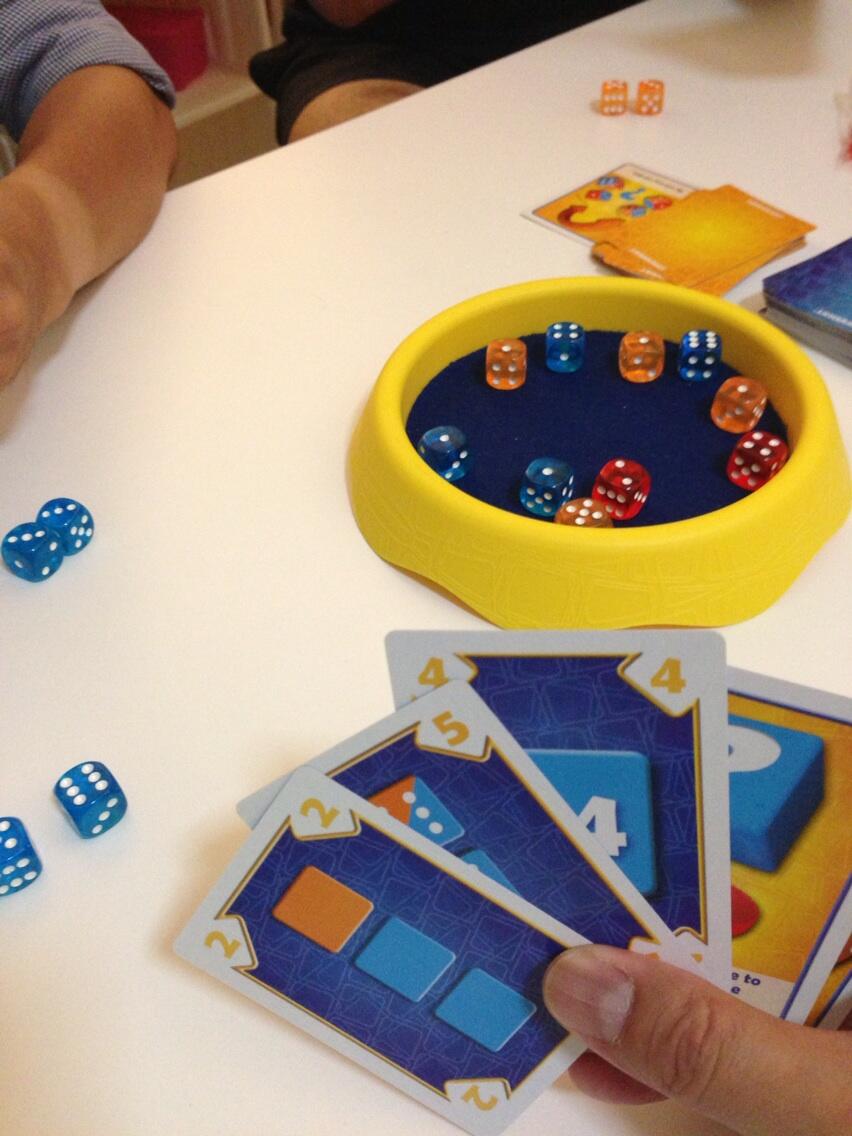 |
| Blue or Orange.. hmm... |
Game Session and Thoughts:
A relatively light filler, each round, 1 player will roll al the dice into the bowl. Then starting with the player that rolled, they will choose 1 die from the bowl and place it in front of them. If they choose the RED die, then they will need to take a -1 Penalty disc as well. Players are trying to match the dice they choose with the cards they have in hand to score points. Each die can only be used for 1 card only. The RED die will count as any color. Players also have an option to play an action card before they select a die. These action cards sometimes allow you to reroll certain number of dice or other benefits to negate the luck of the roll. Finally, players can pass as well. Once all players have passed, then each player reveal the cards they want to complete with the dice they have collected. Any spare die that could not fit any cards will cause the player to collect a -1 Penalty token. Once all players have resolved, they draw back up to 5 cards (combination of action or objective cards) and a new round begins. Game ends after a preset number of rounds and the player tally up the points of the objective cards they have completed minus the penalties and whoever has the most points will win the game.
So as you can tell, this is a light push your luck type of game and is best played with more players because you will need to figure out which card to complete and also determine if you want to go for as many cards as you can and at the same time be mindful of how many dice there are left. The action cards can be quite powerful if you have the right ones but some of them you have to collect a penalty disc for using. Quite fun and a good filler. Dice are really nice as well!
Pet Peeves:
Nothing really bad about this game except perhaps players need to pay attention to what they are trying to achieve as some players could make mistakes with the GREATER THAN and LESSER THAN signs on the cards.
Conclusion:
Quite a fun filler, easy to learn, teach and play. Recommended!
1969
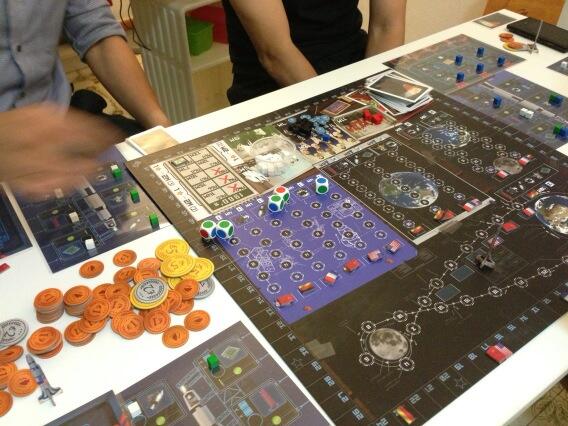 |
| Rocketmannnnnnn........ |
Game Session and Thoughts:
I have heard some mixed reviews about this game but most of them have not been very favourable. Managed to give this game a go and heres what I think. In the game, players represent different countries embarking on a space race and try to score points by achieving certain successes in the various technologies that are required for a successful rocket launch. After several rounds, players in the final round, will be engaged in the final scoring which is launching of the rocket to the moon and back. Players then score final points based on scientists they have (either increase points for prestigious scientists or decrease points for dubious scientists) and the player with the most points will win the game.
Each round, players will first receive income as indicated by that round. Then in turn order (turn order is rotated clockwise), players will then decide how they want to spend the money either by purchasing scientists or buying cards. Scientists are placed onto their player board which will determine how much advancement in a particular technology they provide. Some technologies provide reroll benefits or even money when there has been failed rolls later in the round. After all players have purchased, players again in turn order decide whether to embark on one of the 10 tracks available.
Each player can engage on 6 tracks (excludig the final going to the moon track) and must choose carefully which to engage in. The player after choosing will then roll 5 special die which will either show GREEN (success) or BLUE (neutral) or RED (cancels a success). Players will advance that many spaces as they have overall successes as well as advancements provided by the scientists. Then other players (in player ordeR) may choose to play any number of cards from their hands which will sabotage the current player. Finally the current player will also decide on a number of cards to play. All other players will reveal their cards and they will decrement the current player's token (which is a cardboard rocket ship btw) down that many steps as depicted on the cards played. Finally the current player will increment that many steps as depicted by the cards he played.
Current player will score as many points as the final position and if he was at the top of that track, will be able to advance his token 1 step on the final to-the-moon-and-back track. Play continues until all players have had a chance to tackle a technology track or pass and that round has ended.
At the final round, players will get a chance to do the same but with the final to-the-moon-and-back track. Players then count the final tally of points (from their scientist) and whoever has the most points will be the winner.
It was an average game for me and while not too difficult to learn could be a little confusing. There is quite a lot of negotiation going on because players are trying to shift attention from themselves or convince the rest to play cards to sabotage others. This can be quite costly because each card is not cheap AND can do quite a lot of damage to the current player. There seems to be an interesting loophole where by players can invest in that technology which will provide you with multiples of 3mil whenever you roll a red die. Sometimes bad dice roll can result in you making a LOT of money!
Overall, we all started with vastly different plans mostly to test the mechanisms of the game. I started off with no scientists and try to just go with cards. I was ahead initially but I quickly realised its harder and harder to buy cards and I might as well buy more Green scientists to help myself and provide end game scoring. There was also a moment where we decided to throw our cards in to sabotage 1 player because, well we all felt like it and it did screw up his plans such that when the game ended, he lost the game.
Pet Peeves:
There should have been better icons for the scientists on the board. For example, the red cubes means the scientists counts as 2 instead of the normal 1 for each cube. The Green scientists provide 3 points at the end of the game. The Blue scientists minus 2 points at the end of the game. These could have been shown on the game board.
The art is very gaudy, especially the pictures used for the scientists. Heck, one of them looked as if they were a bunch of wrestlers rather than scientists!
Component wise they used paper money and rather thin player boards which is kinda meh for me.
The luck of the card draw can play quite a significant part in determining how many points a player can gain from track advancement and can screw around with other players. This can be good or bad depending on how the other players take it. Given that each card costs 2mil to purchase, it can be a costly venture if you end up only getting all the lowest point cards.
Luck of the dice roll can also be quite significant because if you want to succeed often you will need quite a high roll of GREEN successes. If you are having a bad dice luck, then it can suck very badly for you.
Conclusion:
As mentioned, it is an average game which I feel is not for me largely because of the sheer amount of luck involved coupled with a fair dose of negotiation. You could very much be locked out of the game if the other players just want to sabotage you all the way and make it very not fun for you. Not many new concepts and it all boils down to how well you can roll initially to how well you can negate cards in the latter phases of the game. Try before you buy!
VITICULTURE
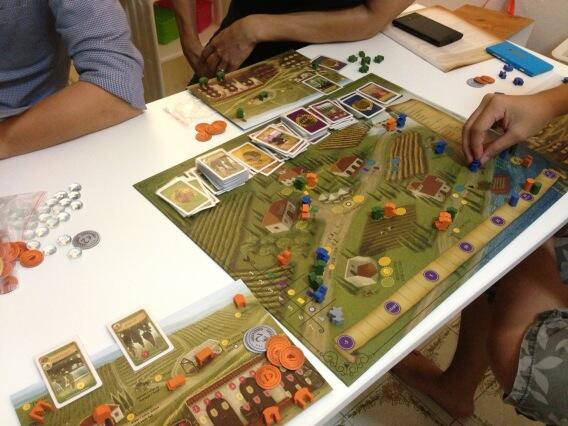 |
| Love the Rooster Meeple.... |
Game Session and Thoughts:
A kickstarter that is to do with wine (hmm recently there have been quite a few wine game huh?) and lighter than Vinhos? Well sign me up! Although I did not backed it when it was Kickstarting, one of my gang managed to and it has arrived!
It is a worker placement game with a player board for you to manage. There are 4 seasons to the game each round and the game ends when 1 player has reached 20 victory points. Player with the most points will win the game. During Spring, players will, in previous player order, choose to move their Rooster to a particular spot ala Fresco. This will determine what bonuses they get AND this current round's player order. Next is summer where players can choose from some of the summer spots to place their worker. Each area which can be chosen as a prime spot that gives extra bonuses (i.e. instead of planting 1 vine, you can plant 2). Players need to manage their workers carefully because they are using the same set of workers for both summer AND winter spots. Once all players have passed, then Autumn comes and players can obtain 1 summer or winter visitor card. These cards often give certain powers/benefits like obtain more $, plant an extra vine. Last season of the year Winter begins and, similar to summer, players will place their remaining workers on the board.
Essentially, Summer is for you to plant vines, get money, construct buildings and play Summer visitor cards. Winter is for you to harvest, crush grapes into wine, fulfil orders and play winter visitor cards. Once all these seasons are done, players age their wine and grapes, discard cards to keep to the hand limit and earn residual income (when you fulfil orders you will get to increment this residual income). So this repeats until a player has reached 20 points and that will trigger the end game.
We played a rule wrongly in that whenever we harvested, we will remove the vineyard cards. But otherwise, we were pretty much spot on. Gameplay was fast and easy to manage and it feels like a medium weight game for me. The worker placement part can be quite competitive and often at least 1 player will be screwed and will have not much to do except to collect $1. Luck of the draw for the vineyard cards etc can be tricky to manage because near the middle of the game the cards I have been drawing does not benefit me at all. Worse, the demand card kinda dictates what you should do with your grapes but then again if you had prepared for it and have a wide variety of wines, that may not be a big issue. Money interestingly was quite important at the beginning of the game but became a moot point nearer the end after you have built most of the buildings.
Components are EXCELLENT! Very nicely produced and many different types of wooden bits. I especially loved the Rooster :P There might be some FAQs required for the text on the cards but the art and design all seemed pretty good. The glass beads are particularly cool because they also help to magnify the number that they are placed on!Pet Peeves:
Biggest pet peeve will be the Luck of the draw could make or break this game for some because a few lucky draws can help you immensely and position for you to win the game. There aren't really that many other pet peeves of the game except perhaps the glass beads could have been a whee bit smaller so that if you had them lined up side by side on the player board they will sit nicely. The size differences between the medium and large cellar are quite small and can be mistaken but as long as you place them on the player board it won't matter.
Conclusion:
The final round was rather tense because it was triggered when I wasn't really prepared for it but I managed, through luck of the draw, to collect a card or two that allowed me to pull ahead and tie with the leader. More importantly, from my play of cards, I screwed up the next player's chances to pull ahead and win the game. In the end, I won by the tie breaker (I had more money) so it was a really close game. I will want to play this again to see how I really feel about it so for now its a Try before you buy.
PHEW! A lot of games covered and my next post will have a lot more as well! Including my first play of Stefan Feld's LATEST release, RIALTO! So watch for it :)
